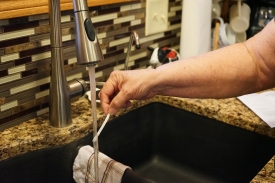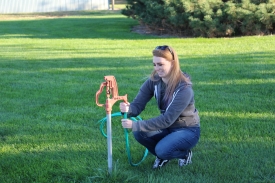Water Testing


Owners’ Responsibility
The NRD offers free analysis for nitrates and bacteria in groundwater. Rural domestic wells are not held to public water system regulations; therefore it is the well owner's responsibility to ensure safe drinking water. These wells should be tested at least once a year for both nitrates and bacteria.
Drinking Water Standards
The safe drinking water standard is ten parts per million for nitrates in public water supplies. Pregnant women, nursing mothers, and babies less than 6 months old are at the highest risk for nitrate poisoning. A condition called methemoglobinemia, commonly known as “blue baby syndrome”, limits the blood’s ability to carry oxygen. This can result in brain damage and even death if not treated promptly. While most wells are free of harmful bacteria it can be introduced into a well during construction or repairs or may enter a well through a crack in the casing or surface seal. It is well documented that certain bacteria pose a serious health risk to humans and livestock. For more information regarding health risks of high nitrates and bacterial contamination please consult with a physician.
You can bring a sample to our office for free quality testing (see info below) or request a simple at-home nitrate test kit that can be mailed to you and will provide immediate results (available in our district only). You can request an at-home test kit by contacting info@upperbigblue.org or (402) 362-6601.
Testing For Nitrates
- You may use your own container, although the NRD will provide a sample bottle if requested.
- The container must be washed and rinsed before the sample is collected
- Collect the sample from a hydrant or faucet that is connected to the waterline closest to the well.
- Do not let the sample pass through a water treatment device (distiller, R/O, softener) unless you wish to test that device’s effectiveness. If you are doing this, we recommend you also provide an untreated sample for comparison.
- Let the water run for at least 10 minutes before collecting the sample.
- Rinse the sample container with water 3 times before collecting the sample.
- Fill the sample container approximately ½ inch from the top.
- Rinse the lid and place it securely on the container.
- If you cannot deliver the sample immediately, it must be refrigerated. Deliver the sample to the NRD office within 24 hours.
- Keep the sample cool during transport.
Testing for Bacteria
- You must use a sterile bottle provided by the NRD. This bottle is sealed and needs to remain sealed until you are ready to collect the sample. These sample bottles are free of charge, as is all water testing done at the NRD.
- Collect the sample from a hydrant or faucet that is connected to the waterline closest to the well.
- Let the water run for at least 10 minutes before collecting the sample.
- Shut off the water.
- Using a match or cigarette lighter, expose the end of the hydrant to the flame for 3-6 seconds. Do not expose the plastic parts to a flame, as it will damage the faucet.
- DO NOT touch the inside of the bottle or lid.
- Carefully fill the sample container to the fill line on the bottle. Do not rinse.
- Secure the cap on the container.
- If you cannot deliver the sample immediately, it must be refrigerated. Deliver the sample to the NRD office within 24 hours.
